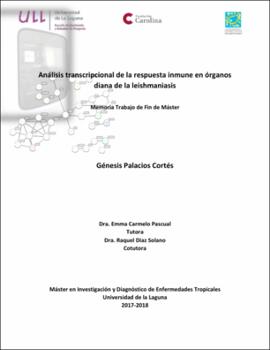Análisis transcripcional de la respuesta inmune en órganos diana de la leishmaniasis
Autor
Palacios Cortés, GénesisFecha
2018Resumen
The study of the immunological mechanisms in the infection by Leishmania sp, requires the
evaluation of the gene expression in vivo, many studies have provided information about what
happens at the in vitro level, but the knowledge of the changes at the transcriptome level using the
murine model, from tissue of the affected organ, in this case the liver, would allow to obtain an
overview of gene expression and a better approach to the immune response in humans. Therefore,
in the present study it was proposed to know the gene expression in a first moment of the infection
(at 24 hours), from liver tissue of BALB/c mice infected with L. infantum, and samples from
uninfected mice as control group. From the RNA extraction and with the retrotranscription
products, High-throughput Real-time quantitative PCR was performed to know the expression of
112 genes related to the immune response. Among the main findings, it is possible to highlight that
24 hours post infection predominates the expression of genes involved in the inflammatory
response of macrophage activation (M1) where Stat1 seems to have a central role in the innate
immune response, since it connects the genes involved in the production of IFN-γ with the genes
related to leukocyte chemotaxis. At this time of infection, chemotactic signals have already been
generated for T lymphocytes, NK cells and monocytes. Additionally, the detection of costimulatory
molecules such as CD40/CD40LG would indicate that activation of CD4+ T lymphocytes is taking
place. It also highlights the overexpression of Ifng and Nos2, which It indicates that it would be
producing macrophage activation by the classical pathway, important for infection control
mechanism in the liver.





